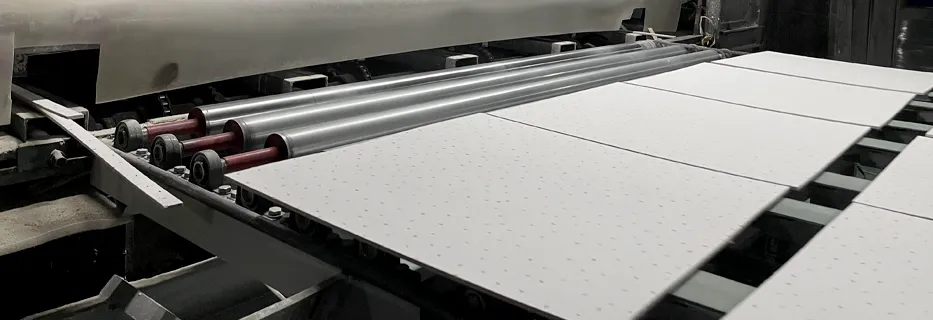- Afrikaans
- Albanian
- Amharic
- Arabic
- Armenian
- Azerbaijani
- Basque
- Belarusian
- Bengali
- Bosnian
- Bulgarian
- Catalan
- Cebuano
- Corsican
- Croatian
- Czech
- Danish
- Dutch
- English
- Esperanto
- Estonian
- French
- German
- Greek
- Hindi
- Indonesian
- irish
- Italian
- Japanese
- Korean
- Lao
- Malay
- Myanmar
- Norwegian
- Norwegian
- Polish
- Portuguese
- Romanian
- Russian
- Serbian
- Spanish
- Swedish
- Thai
- Turkish
- Ukrainian
- Uzbek
- Vietnamese
আগস্ট . 13, 2024 04:32 Back to list
Exploring the Benefits and Applications of Mineral Fiber Suspended Ceilings in Modern Architecture
Mineral Fibre Suspended Ceilings An Overview
Mineral fibre suspended ceilings, also known as acoustic ceilings or drop ceilings, have become a popular choice in commercial and residential construction. These ceilings are composed primarily of mineral-based materials, which provide numerous functional and aesthetic benefits. This article explores the characteristics, advantages, installation processes, and applications of mineral fibre suspended ceilings.
Characteristics of Mineral Fibre Suspended Ceilings
Mineral fibre ceilings are typically made from a blend of natural minerals, such as gypsum, along with other materials that enhance their performance. These ceilings are lightweight, easy to handle, and can be manufactured in various sizes and finishes. The surface of mineral fibre tiles can be smooth, textured, or patterned, allowing for creative design options tailored to the architectural requirements of a space. Additionally, the tiles are available in various colors, enabling further customization.
One of the most notable characteristics of mineral fibre ceilings is their sound absorption properties. The porous nature of mineral fibres allows them to trap sound waves, thereby reducing noise levels in a room. This quality makes them ideal for environments where acoustic control is crucial, such as offices, schools, and auditoriums.
Advantages of Mineral Fibre Suspended Ceilings
The benefits of mineral fibre suspended ceilings are numerous. Firstly, they are excellent insulators, providing thermal resistance that contributes to energy efficiency in buildings. By maintaining consistent temperatures, they can help reduce heating and cooling costs.
Secondly, these ceilings are designed to improve indoor air quality. Many mineral fibre tiles are treated to resist mold and mildew, making them suitable for areas with high humidity. Additionally, they can be manufactured with recycled content, adding an eco-friendly aspect to their use.
mineral fibre suspended ceiling

Thirdly, installation and maintenance are straightforward. Mineral fibre ceilings are installed in a grid system that allows for easy access to the space above the ceiling. This feature is particularly valuable for maintenance of HVAC systems, electrical wiring, and plumbing. Tiles can be easily removed and replaced without disturbing the entire ceiling structure.
Installation Process
The installation of a mineral fibre suspended ceiling involves several steps. First, a grid system is attached to the existing ceiling or framework, which serves as a support structure for the tiles. This grid can be adjusted to accommodate different heights, ensuring a level and aesthetically pleasing final product. Next, the mineral fibre tiles are simply dropped into the grid. This drop-in method allows for flexibility, as tiles can be replaced or repositioned with ease.
Applications of Mineral Fibre Suspended Ceilings
Mineral fibre suspended ceilings find applications across a variety of sectors. In commercial spaces like offices and conference rooms, they provide acoustic control necessary for a productive work environment. Retail locations benefit from their design versatility, allowing businesses to create a unique atmosphere that aligns with their branding.
In educational settings, these ceilings contribute to a focused learning environment by minimizing noise distractions. Healthcare facilities also utilize mineral fibre ceilings, as their easy maintenance and mold-resistant properties are crucial in maintaining sterile and healthy spaces.
Conclusion
In conclusion, mineral fibre suspended ceilings offer a combination of aesthetic appeal, sound absorption, energy efficiency, and ease of maintenance. Their versatile applications make them suitable for various settings, from commercial to residential spaces. As building design continues to evolve, the demand for efficient and stylish ceiling solutions like mineral fibre suspended ceilings is likely to grow, reinforcing their place in modern architecture.
-
PVC Laminated Gypsum Ceiling Board OverviewNewsApr.11,2025
-
Mineral Fiber Ceiling Tiles Price Analysis and ComparisonsNewsApr.11,2025
-
Crafts of Mineral Fiber Ceiling Tile ManufacturingNewsApr.11,2025
-
Difference Between Gypsum and PVC CeilingNewsApr.11,2025
-
An Overview of Mineral Fiber Ceiling TilesNewsApr.11,2025
-
Advantages of PVC Gypsum CeilingNewsApr.08,2025







